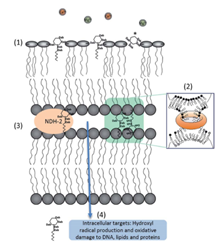Biointerfaces
Novel lipopeptide antibiotics
Antimicrobial resistance (AMR) is now a major global public health threat, with the yearly charge of AMR being estimated at around € 1.5 Billion and 25000 deaths in Europe. There is an urgent need for new antimicrobials for clinical use, but only two new classes of antibiotics have been brought to market in the last 30 years. Specially dangerous are resistant Gram-negative infections caused by Pseudomonas aeruginosa, Acinetobacter baumannii and Enterobacteriaceae (i.e., Escherichia coli or Klebsiella pneumoniae), that are particularly prone to acquire resistance to current antibiotics.

Our group is interested in developing new antibiotic lipopeptides that target Gram-negative bacteria and are able to kill them with only a few molecules of peptide per cell, resulting in very low MICs. This is because they act by a specific mechanism that involves lipid exchange between the inner and outer membranes, causing an effect similar to osmotic shock. The ultimate goal of our research is to develop novel antimicrobial lipopeptides that are highly active against resistant bacteria and at the same time have low toxicity. In collaboration with the group of Francesc Rabanal, at the department of Organic Chemistry-UB we have developed new candidate molecules with MICs in the low micromolar range and with low toxicity in in vivo animal models. Biophysical studies with model membranes in combination with flow cytometry and TEM observation in susceptible bacteria are indicative of a membrane-based mechanism of action. As model membranes we use unilamelar vesicles (liposomes) and monolayers with a composition that mimics the membranes of susceptible bacteria, and use a battery of biophysical methods to dissect the peptide-lipid interaction and unravel the molecular basis of the mechanism of action.

Other affiliations
Peptides and proteins: Physicochemical studies. Grup de recerca consolidat de la Generalitat de Catalunya.
Member of the Institute of Nanoscience and Nanotechnology (IN2UB) of the University of Barcelona
Last grants obtained
Noves polimixines per al tractament d’infeccions causades per bacteris multiresistents. MARATÓ TV3 201829-10 (2019-22) (IP: F. Rabanal)
Discovery and development of new drugs combating Gram negative infections: New Drugs for bad Bugs, ENABLE (European Network for AntiBiotic Lead Engine). WP4c, hit CycLP(cyclolipopeptides). FP7 Seventh Framework Programme of European Commission EC 115583 / FBG 401200 (2014-2021) (IP: F. Rabanal)
Nuevas polimixinas de muy baja toxicidad contra bacterias multirresistentes de importancia clinica. Exploración de su potencial como agentes anticancerosos. Ministerio de Ciencia, Innovación y Universidades, RTI2018-098641-B-I00 (2019-2021), (IP: F. Rabanal)
Design, synthetic development, biophysical study and biological evaluation of cyclic lipopeptides as new antimicrobial and anticancer compounds, Ministerio de Educación y Ciencia, CTQ2008-06200/BQU (2009-2011) (IP: F. Rabanal)
New broad-spectrum antibiotics, Centre d’Innovació i Desenvolupament Empresarial CIDEM (Generalitat de Catalunya) VALTEC 08-1-0016 (2008-2011)
Selection of publications
Amanda Cano, A.; Ettcheto, M.; Espina M.; López-Machado, A.; Cajal, Y.; Rabanal F.; Sánchez-López, E.; Camins, A.; García M. L.; Souto, E. B. State-of-the-art polymeric nanoparticles as promising therapeutic tools against human bacterial infections, J Nanobiotechnol 18,156, 2020
Rabanal F., Cajal, Y. Recent advances and perspectives in the design and development of polymyxins. Nat. Prod. Rep, 34, 886-908, 2017
Rudilla, H. Fusté, E. Cajal, Y. Rabanal, F. Vinuesa, T. Viñas, M. Synergistic antipsedomonal effects of synthetic peptide AMP38 and carbapenems. Molecules 21, 1223, 2016
Grau-Campistany A., Manresa A., Pujol M., Rabanal F., Cajal Y. Tryptophan-containing lipopeptide antibiotics derived from polymyxin B with activity against Gram positive and Gram negative bacteria. Biochimica Biophysica Acta 1858, 333-343, 2016
Rabanal F., Grau-Campistrany A., Vila-Farrés X., Gonzalez-Linares J., Borràs M., Vila J., Manresa A., Cajal Y. A bioinspired peptide scaffold with high antibiotic activity and low in vivo toxicity. Scientific Reports 5-10558, 1-11, 2015
Rabanal F., Cajal Y. Therapeutic potential of antimicrobial peptides. In “New Weapons to Control Bacterial Growth”, pp. 433-452, M. Viñas Ciordia & Tom G. Villa (Eds), (Germany) Ed. Springer International Publishing Switzerland. ISBN 978-3-319-28366-1, 2016.
Grau-Campistany A., Pujol M., Marqués A.M., Manresa A., Rabanal F., Cajal Y. Membrane interaction of a new synthetic antimicrobial lipopeptide sp-85 with broad spectrum activity. Colloids and Surfaces A 480, 307-317, 2015
Collaborations
UB: Neurotoxicity studies: Dr. Antoni Camins; Nanoencapsulation: Dr. Elena López; Dr. Amanda Cano; Toxicity in Zebrafish: Dr. Marta Barenys; Microbiology (MIC determinacion): Dr. Ana Marqués, Dr. Maribel Farfan
In vivo studies: Mª Eugènia Pachón Ibánez (Universidad de Sevilla)
Resistant bacteria: Dr. Jordi Vila (ISGlobal)
ENABLE groups (Uppsala, Stockholm, Copenhaguen, Riga)
No s'han trobat entrades.

